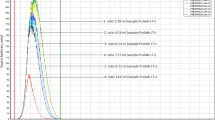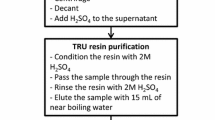Abstract
Several studies were carried out to optimise rapid tritium analysis in fresh waters by ultra-low background liquid scintillation. These included the optimisation of (1) sample/scintillant ratio, (2) pulse shape analysis, and (3) pulse-amplitude comparator, and studies concerning (1) the combination scintillant/vial and (2) the effect of chemiluminescence. The proposed method involves the mixing of 8 ml sample with 12 ml scintillation cocktail Ultima Gold AB in Zinsser low diffusion vials. These are stored during one day before counting in order to reduce chemiluminescence. The minimum detectable activity achieved was 2.2 Bq·l−1 for a total counting time of 360 minutes. In order to test the method, tritium was determined in Ebro river samples.
Similar content being viewed by others
References
J. W. Lloyd, in: Case-studies in Groundwater Resources Evaluation,J. W. Lloyd (Ed.), Clarendon Press, Oxford, London, 1981, p. 113.
B. E. Lehmann, S. N. Davis, J. T. Fabryka-Martin, Water Resour. Res., 29 (1993) 2027.
J. A. Sanchez-Cabeza, Ll. Pujol, Water Res. (in press).
H. Mundschenk, W. J. Krause, J. Environ. Radioact., 14 (1991) 341.
S. D. Castellano, R. P. Dick, Health Phys., 65 (1993) 539.
S. Okada, N. Momoshima, Health Phys., 65 (1993) 595.
C. E. Murphy, Health Phys., 65 (1993) 683.
F. Schönhofer, Radiocarbon, 34 (1992) 768.
UNSCEAR, Ionizing Radiation: Sources and Effects of Ionizing Radiation, United Nations, New York, 1993.
J. E. Noakes, S. De Filippis, in: 2nd Intern. Seminar for LSA, Packard Japan K.K., Tokyo, 1988, p. 123.
Ll. Pujol, PhD Thesis, Universitat Autònoma de Barcelona, 1996.
L. A. Currie, Anal. Chem., 40 (1968) 586.
L. Kaihola, in: International Seminar on Low-level Counting in Environmental Radioactivity Monitoring, Estonian Academy of Sciences, Tallinn, Estonia, 1990.
F. Schönhofer, in: Low-level Measurements of Radioactivity in the Environment. Techniques and Applications,M. García-León, R. García-Tenorio (Eds.), World Scientific, Singapore, 1994, p. 155.
J. A. Sanchez-Cabeza, Ll. Pujol, J. Merino, L. León, J. Molero, A. Vidal-Quadras, W. R. Schell, P. I. Mitchell, in: Intern. Conf. on Advances in Liquid Scintillation Spectrometry 1992,J. E. Noakes, F. Schönhofer, H. A. Polach (Eds.), Radiocarbon, Tucson, Arizona, 1993, p. 43.
J. A. Sanchez-Cabeza, Ll. Pujol, Health Phys., 68 (1995) 674
J. A. Sanchez-Cabeza, Ll. Pujol, Analyst, 123 (1998) 399.
L. Kaihola, Sci. Total Environ., 130/131 (1993) 297.
D. L. Horrocks, A. J. Kolb, Laboratory Practice, 30 (1981) 481.
ISO, Water quality — Determination of tritium activity concentration — Liquid scintillation counting method, International Organization for Standardization, Genève, 1989.
Ll. Pujol, J. A. Sanchez-Cabeza, J. Environ. Radioact. (in press).
Author information
Authors and Affiliations
Rights and permissions
About this article
Cite this article
Pujol, L., Sanchez-Cabeza, J.A. Optimisation of liquid scintillation counting conditions for rapid tritium determination in aqueous samples. J Radioanal Nucl Chem 242, 391–398 (1999). https://doi.org/10.1007/BF02345568
Received:
Issue Date:
DOI: https://doi.org/10.1007/BF02345568




